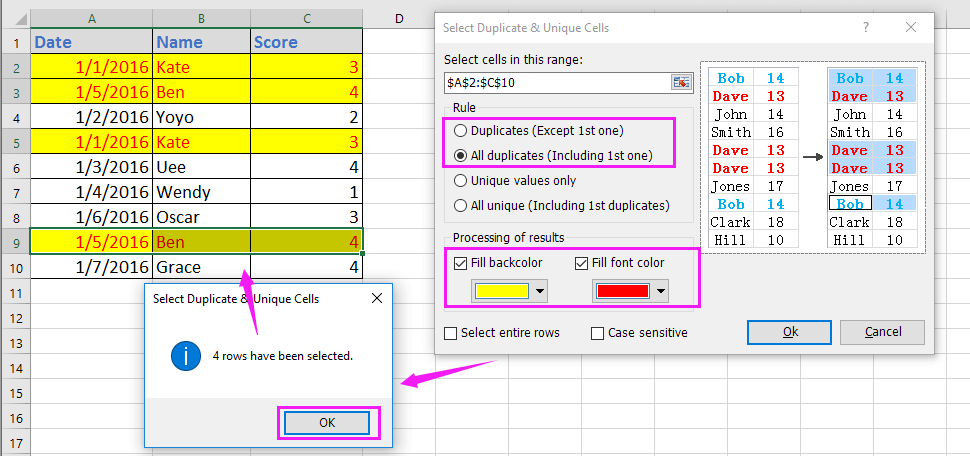Find Duplicate Values Across Excel Sheets Easily

In today's data-driven world, managing and analyzing large sets of data efficiently has become crucial for businesses and individuals alike. One common task in Excel that can be quite time-consuming is finding duplicate values across multiple sheets. While Excel offers a variety of tools for data manipulation, locating duplicates across sheets isn't directly supported. This blog post will guide you through the steps to effortlessly find duplicate values in Excel across multiple sheets, ensuring your data analysis workflow is streamlined.
Why Finding Duplicates Across Sheets Is Important

Before diving into the methods, let’s understand why finding duplicates across different sheets matters:
- Data Consistency: Ensures all data across sheets remains consistent, reducing errors.
- Data Integration: Helps in integrating data from different sources or departments.
- Efficiency: Saves time by automating the process, which can be otherwise manual and error-prone.
- Error Detection: Quickly spot and rectify discrepancies or data entry mistakes.
Manual Methods to Find Duplicates Across Excel Sheets

If you’re dealing with a small dataset, you might still prefer manual approaches. Here’s how you can do it:
Using Conditional Formatting

- Select the data range in the first sheet where you want to find duplicates.
- Go to Home > Conditional Formatting > New Rule.
- Choose Use a formula to determine which cells to format.
- In the formula box, type a formula like
=COUNTIF(Sheet1!A:A,A1)>1to check for duplicates in the first column. - Apply formatting to highlight cells with duplicates.
- Repeat for other sheets.
🔎 Note: This method works best for a single column, and you might need to adjust the formula for different sheets and data ranges.
Using VLOOKUP Function

- In a new sheet or column, use the
VLOOKUPfunction. For example, if your data is in Sheet1!A:A, you’d write=IF(ISNA(VLOOKUP(A2,Sheet2!A:A,1,FALSE)),“Unique”,“Duplicate”). - Drag the formula down to check each row.
- Copy and paste the formula for all sheets you want to compare.
Automated Solutions with VBA

For those dealing with larger datasets, a VBA script can automate the process:
Step-by-Step to Create a VBA Macro

- Open Excel and press Alt + F11 to open the VBA Editor.
- Insert a new module (Insert > Module).
- Enter the following VBA code:
Sub FindDuplicatesAcrossSheets() Dim ws As Worksheet, wsCheck As Worksheet, rng As Range, cell As Range Dim dict As Object, key As Variant Set dict = CreateObject(“Scripting.Dictionary”)For Each ws In ThisWorkbook.Worksheets If ws.Name <> "Sheet1" Then 'Assuming Sheet1 is the new sheet for results Set rng = ws.Range("A2", ws.Cells(ws.Rows.Count, "A").End(xlUp)) 'Change A if your data starts elsewhere For Each cell In rng If Not dict.Exists(cell.Value) Then dict.Add cell.Value, ws.Name Else Sheets("Sheet1").Range("A" & Rows.Count).End(xlUp).Offset(1, 0).Value = cell.Value End If Next cell End If Next wsEnd Sub
- Close the VBA Editor and return to Excel.
- Run the macro by pressing Alt + F8, selecting FindDuplicatesAcrossSheets, and clicking Run.
📝 Note: The macro will list all duplicate values found in the sheet named "Sheet1". Adjust the script for your specific needs.
Third-Party Add-Ins for Duplicate Detection

If you’re not comfortable with VBA or prefer a more user-friendly approach, consider using third-party Excel add-ins:
- Power Query: Included in recent versions of Excel, it allows you to combine multiple sheets into one and then easily find duplicates.
- Kutools for Excel: Provides a ‘Find Duplicate Values’ feature that can look across all sheets.
- XL Comparator: An external tool designed specifically for comparing and finding duplicates across Excel workbooks and sheets.
Here's how you can use Power Query:
- From the Data tab, select Get Data > From Other Sources > Blank Query.
- In the Query Editor, combine data from all sheets (Advanced Editor might be helpful here).
- After merging, use the Group By function to identify duplicates.
In conclusion, finding duplicate values across multiple Excel sheets, although not natively supported by Excel, can be efficiently managed through manual methods, VBA, or third-party tools. Each method has its advantages, catering to different user preferences and dataset sizes. By implementing these techniques, you'll not only streamline your data analysis but also ensure your datasets remain consistent and error-free. Whether you opt for the hands-on approach with conditional formatting or leverage the power of VBA scripts, the ability to detect and manage duplicates is a key skill in data management.
Can I find duplicates between two sheets without VBA?

+
Yes, you can use methods like Conditional Formatting or the VLOOKUP function to manually check for duplicates. These methods are suitable for smaller datasets and can be implemented without VBA.
Is there an Excel formula to check for duplicates across sheets?

+
While there isn’t a built-in formula, you can combine functions like IF, ISNA, and VLOOKUP to create a formula-based solution for checking duplicates across sheets.
What are the limitations of manual methods?

+
Manual methods become impractical with large datasets due to time and error issues. They also require a more hands-on approach, making them less suitable for automation and integration across multiple sheets.